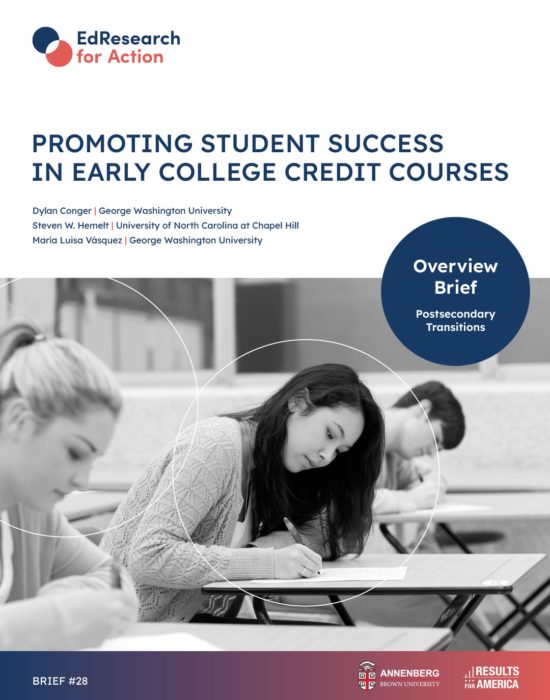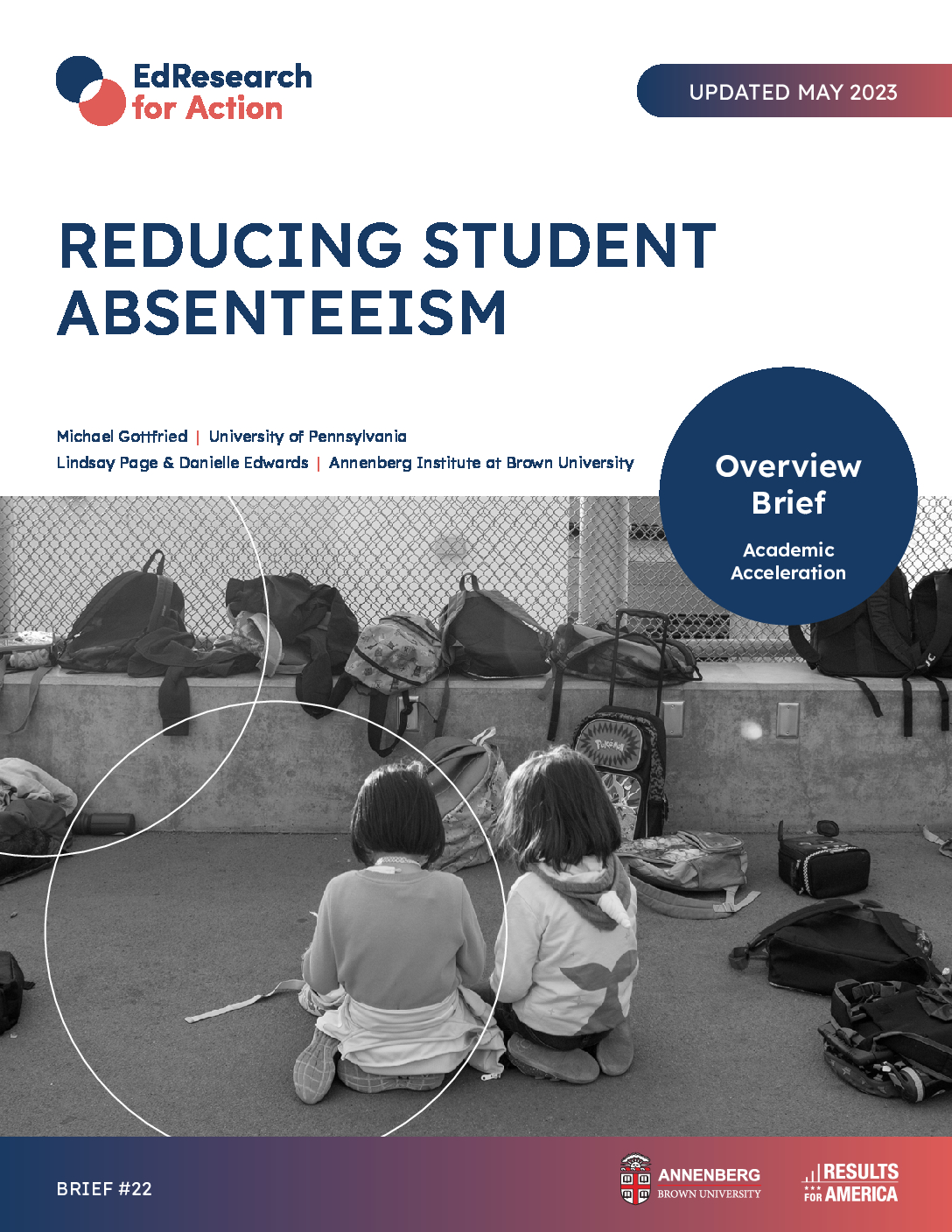REDUCING STUDENT ABSENTEEISM
The EdResearch for Action Overview Series summarizes the research on key topics to provide K-12 education decision makers and advocates with an evidence base to ground discussions about how to best serve students. Authors – leading experts from across the field of education research – are charged with highlighting key findings from research that provide concrete, strategic insight on persistent challenges sourced from district and state leaders.
Michael A. Gottfried | University of Pennsylvania
Lindsay Page | University of Pittsburgh
Danielle Edwards | Brown University
May 2023 | Brief No. 22
Central Question
What are evidence-based practices that schools can implement to reduce student absenteeism?
Key Insights
Evidence-Based Practices: Tier 1
- Investments in safer and more accessible transportation can lead to significant improvements in student attendance.
- Evidence suggests that school interventions that support children and families in managing the morning transition to school can raise attendance.
- Attendance interventions that target physical and mental health needs tend to be particularly effective. Since the start of the COVID pandemic, this has become more important than ever.
- Specific parental communication routines have been shown to raise parental awareness of student attendance issues and improve attendance rates.
- Home visits by nurses or teachers often provide useful insights into why children are chronically absent, while also fostering stronger relationships between families and schools.
- Students are more engaged — and more likely to attend school — when their schoolwork connects to their own identity and when they feel a sense of belonging at school.
Evidence-Based Practices: Tier 2
- Data systems that identify students for increased support based on attendance, behavior, and academic metrics can facilitate targeted efforts to reduce chronic absenteeism.
- School-based mentorship programs have been shown to improve attendance and academic outcomes for students at all grade levels.
Evidence-Based Practices: Tier 3
- School partnerships with other public agencies and community-based organizations show promise for comprehensively responding to complex challenges some students face to strong school attendance.
- For frequently absent students, absence intervention teams that holistically respond to causes of student truancy have been found to be more effective than strategies that punish students with suspension or expulsion.
Breaking Down the Issue
What is chronic absenteeism and how prevalent is it?
Since long before the COVID pandemic, public schools across the United States have contended with high rates of absenteeism. During the 2015-16 school year, for example, 16% of the nation’s students, or more than 7 million children, missed 15 or more school days. At most schools — urban, rural, and suburban schools alike — anywhere from 5% to 25% of students miss at least 18 days per year (or more than 10% of school days, which is commonly defined as the threshold for chronic absenteeism).
Rates of absenteeism are high across all student populations, but rates are highest among specific subgroups. For example, low-income students and students with disabilities tend to miss school more often than other students, and black students are more likely to be chronically absent than their white peers. Rates differ by grade level, as well. More than 20% of students in high school are chronically absent, compared with more than 14% of students in middle school and almost 14% in elementary school.
What do we know about the causes and effects of chronic absenteeism?
Across all grade levels, transportation challenges, student health, and poverty drive absenteeism rates, but school climate has also been shown to matter considerably.
- Families report that transportation access is the largest barrier to school attendance. Notably, students who walk through dangerous neighborhoods to get to school, or who have long commutes to school, have lower attendance rates.
- Districts located in cities with higher rates of asthma and colder weather tend to have a higher percentage of chronically absent students. Further, poor classroom ventilation is associated with increased absences due to illness.
- Children who enjoy school are less likely to be chronically absent, while children who report conflicts with teachers and other students are more likely to miss school. And when parents engage with student learning by attending school events, students are more likely to attend school regularly.
- Students living in neighborhoods with higher poverty levels, lower homeownership rates, and more violent crimes have more absences.
To some extent, the causes of chronic absenteeism vary by grade.
- Kindergarten absenteeism is most frequently associated with family-specific factors such as inconsistent work schedules, parental illness, unstable housing, and lack of social or economic resources. Although not as prevalent, student-specific factors such as anxiety or fear of going to school can also be sources of absenteeism in kindergarten.
- Chronic absenteeism among high school students is more strongly correlated with student- and school-factors, such as fear of bullying, disinterest in schoolwork, negative perceptions of school and teacher, and negative academic self perception.
- Chronically absent middle and high school students often report personal stress as a reason they are absent from school. Further, the rates of childhood depression, anxiety, and suicidal ideation have significantly increased since the onset of the COVID-19 pandemic, and researchers speculate that this could lead to even higher rates of absenteeism among middle and high school students in the coming years.
- Chronic absenteeism tends to spike at key points in the education system, such as the beginning of formal education (in kindergarten and first grade), transitions into middle and high school, and the final year of high school (senior year). Researchers speculate that this is because these transitions require adjusting to new and larger school environments, as well as to different teachers, curriculum, and subjects. This can cause anxiety and disengagement, which can lead to increased absenteeism.
While chronic absenteeism has adverse effects on all students, the effects are especially harmful for specific student populations and at certain grade levels.
- The effects of chronic absence appear to be most serious for low-performing, low-income, and English learner students. Absences are about 25% more harmful to the reading achievement of low-income students compared to their higher income peers. The effect of absences on English learners’ reading achievement is more than twice as large as the effect of absences on non-English learners’ reading achievement. And evidence suggests that absences are marginally more harmful to previously low-achieving students compared to higher achieving students.
- Chronic absenteeism is associated with negative spillover for classmates who are not themselves chronically absent (but who are, by virtue of school enrollment patterns, also more likely to be low-performing, low-income, and/or English learners). Notably, in classes with higher percentages of chronically absent students, other students (with better attendance records) tend to have lower test scores.
- Students who are chronically absent in kindergarten have lower attendance rates and achievement in subsequent grades. Missing large amounts of school in early grades can also negatively impact social-emotional development and lead to a decrease in social interaction with classmates. Further, students who miss school during these years may be more likely to exhibit behavioral issues later on. According to one study, students who frequently missed school in kindergarten were at double the risk of being suspended by 7th grade as compared to their peers with high attendance.
Evidence-Based Practices
What does the research say about effective ways to reduce chronic absenteeism?
In recent years, school systems and community groups across the country have launched targeted campaigns and interventions to reduce student absenteeism, but they’ve met with varying degrees of success. While some schools and districts have seen significant improvements, others have not, and rates of absenteeism remain high in every state.
Researchers have learned important lessons from these efforts, however, and they’ve found that certain strategies do tend to be effective:
TIER 1 PRACTICES: Reaching all students with broad-based and preventative supports
Investments in safer and more accessible transportation can lead to significant improvements in student attendance.
- Having reliable access to school is associated with higher attendance for all students, particularly those in rural areas and those from low-income or single-parent households.
- More targeted transportation support may be needed for students who are homeless, live in foster care, have disabilities, live in rural settings, travel long distances to school, or exhibit signs of chronic absence. Recent innovations in transportation efforts (not yet backed by rigorous evidence) include door-to-door van services, ride-sharing services, and family carpool coordination.
- In urban contexts contending with high rates of crime, monitoring common walking routes and facilitating students to walk to school in large groups show promise for ensuring safe travel to school.
Evidence suggests that school interventions that support children and families in managing the morning transition to school can raise attendance.
- Morning routines can be stressful for many parents and caregivers, making it difficult for them to get children to school on time. Schools can ease the transition by helping families access laundry services and public transportation or by arranging school-partnered ride shares and school breakfast programs.
- Researchers have found that when teachers create a morning routine for greeting students as they arrive at school, engagement and attendance tend to improve.
Attendance interventions that target physical and mental health needs tend to be particularly effective. Since the start of the COVID pandemic, this has become more important than ever.
- School infrastructure remains an important factor for many attendance interventions and is especially so for students with breathing-related diseases. Examples include efforts to ensure proper ventilation and remove asbestos.
- In-school health services (including school nurses, school-based health centers, dental care, vaccinations, and mental health counseling) can significantly improve students’ well- being, which tends to lead to improved attendance. Hybrid models that combine on-site and telemedicine show particular promise for increasing access to treatment for asthma and dental problems.
Specific parental communication routines have been shown to raise parental awareness of student attendance issues and improve attendance rates.
- Because parents often underestimate how much school their child has missed, many districts send home regular attendance reports via text messaging or flyers. In Philadelphia, an experimental study found that when such personalized mailers were sent home to parents, chronic absenteeism was reduced by 10% or more.
- Two-way text messaging can facilitate faster identification of and response to barriers to regular attendance. In Pittsburgh, for example, a two-way text-messaging pilot program encouraged parents of kindergartners to seek advice from school staff when they faced challenges (such as having to figure out a new bus route after moving to a new neighborhood) that might have caused their children to miss school. In the program’s first year, researchers found, chronic absenteeism declined significantly.
- However, while school- and community-wide messaging campaigns promoting attendance show promise, they must be designed with care. Evidence suggests that positive messaging about maintaining a strong attendance record (including messages about financial and other incentives to do so) are more effective than messaging focused on reducing absenteeism, which could be construed as punitive.
Home visits by nurses or teachers often provide useful insights into why children are chronically absent, while also fostering stronger relationships between families and schools.
- Home visiting programs have been associated with reductions in chronic absenteeism, particularly among students whose families did not previously have a strong relationship with the school.
- Such visits can encourage better attendance even when they do not focus explicitly on that topic. For example, when teachers engage parents in conversation about their hopes and dreams for their children, this often results in a more positive and trusting home-school relationship, which, in turn, can lead to improved attendance.
Students are more engaged — and more likely to attend school — when their schoolwork connects to their own identity and when they feel a sense of belonging at school
- Courses employing culturally relevant pedagogy can improve academic performance and attendance, particularly among lower-performing students.
- Conversely, when children feel excluded from the school community, attendance tends to decline. For instance, researchers have found lower rates of engagement and attendance among students with disabilities when they are assigned to a self-contained special education classroom.
TIER 2 PRACTICES: Targeting students with signs of risk
Data systems that identify students for increased support based on attendance, behavior, and academic metrics can facilitate targeted efforts to reduce chronic absenteeism.
- By analyzing data from their existing early warning indicator systems, a host of urban school districts were able to identify and provide targeted support to middle grade students who had begun to show a pattern of missing class, resulting in significant reductions in chronic absenteeism. Similarly, after identifying 9th graders showing early signs of chronic absenteeism and low academic performance, the Chicago Public Schools responded by providing mentoring, summer support, and family outreach. The on-track status of 9th grade students across the district rose nearly 30 percentage points following these efforts.
School-based mentorship programs have been shown to improve attendance and academic outcomes for students at all grade levels.
- Offering mentor programs and pairing students with role models can lead to improved motivation to come to school. Effective programs (which are sometimes combined with other health and social services) often include partnerships with community-based organizations, which can reduce the burden on school staff to identify and supervise mentors.
- Researchers have found that participation in mentoring programs such as Check & Connect, My Brother’s Keeper, City Year, and Peer Group Connection often lead to improved attendance and other positive outcomes in elementary, middle, and high school contexts. Common features of these programs include using attendance data to target students for support and connecting students with mentors for a sustained period of time.
- Similarly, youth school engagement programs, such as Positive Action and Becoming a Man, have led to improvements in school attendance, particularly for students from low-income backgrounds residing in urban contexts.
TIER 3 PRACTICES: Responding to chronic absenteeism with coordinated supports
School partnerships with other public agencies and community-based organizations show promise for comprehensively responding to complex challenges some students face to strong school attendance.
- The Full-Service Community Schools (FSCS) and Communities in Schools models are run by non-profit organizations that place staff coordinators in schools to analyze student data, identify needs, and connect students and their families to needed resources. In New York City, schools that participated in FSCS saw, in comparison to similar schools that did not participate, reduced chronic absenteeism across elementary, middle, and high schools targeted for support. The FosterEd program, which targets children in the child welfare and justice systems, also shows promise for improving students’ attendance by connecting them to a coordinated support team that can include social workers, therapists, teachers, and students’ court-appointed special advocates.
- Partnerships between schools and homeless services show promise for improving attendance among homeless students. A partnership in New York City facilitated student placement in schools and the development of in-shelter homework centers. Attendance data from May 2019 showed that those who participated were substantially less likely to be chronically absent than they were the previous May.
For frequently absent students, absence intervention teams that holistically respond to causes of student truancy have been found to be more effective than strategies that punish students with suspension or expulsion.
- In Kentucky, a school-court partnership implemented a positive mediation-type program designed to identify the underlying barriers to school attendance and establish an individual education plan for each child. The program provided families of truant students with workshop training followed by meetings and case management from court and school staff, which resulted in improved student attendance and academic performance.
- Restorative justice efforts, which focus on inclusionary, non-punitive responses to student misbehavior, have shown reduced suspension and absence rates in schools that implement it well, such as in Pittsburgh, Minnesota, and Houston.
Practices to Avoid
What strategies have been proven ineffective?
Attendance awards often backfire.
- Once students have received an award for good attendance, their attendance will often decline in the subsequent days and weeks. When surveyed about this pattern, students have explained that such awards signal to them that they can now afford to miss class. Any future absences, they reason, will be balanced out by their good behavior in the past. This effect has been found most often among academically low-performing students.
- When teachers announce ahead of time that they plan to give such awards, younger students are often motivated to improve their attendance, but the incentive rarely motivates older students. Further, once they’ve won the award, students of all ages tend to see their attendance decline.
Punitive school discipline strategies tend to reduce engagement and attendance.
- The negative effects of school-level exclusionary punishments, such as suspensions and expulsions, on student attendance have been well documented, particularly for students of color.
- Additionally, one study found that students assigned to more punitive teachers also had higher numbers of absences. This suggests that the harshness with which teachers decide to punish students for misbehavior in the classroom likely harms their relationships with students and leads to disengagement.
Strategies that rely too heavily on external organizations can become too complex and unwieldy.
- Partnering with external organizations can be helpful, particularly for serving students facing complex challenges such as health crises and homelessness. But it can also increase the number of people and offices involved and make it harder for schools themselves to drive the work.
- Outside agencies may also have non-educational goals, such as addressing neighborhood quality, that lie beyond the scope of school systems.
This EdResearch for Action Project brief is a collaboration among:



Funding for this research was provided by the Bill & Melinda Gates Foundation. The findings and conclusions contained within are those of the authors and do not necessarily reflect positions or policies of the foundation.




